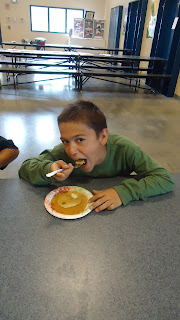 Cooking for and with elementary
students is hard work. Organizing a class of twenty in making something palatable can quickly
devolve into chaos, and you always run the risk that they won’t like whatever
you’re serving. Figuring out how to handle that is a lesson in itself.
Cooking for and with elementary
students is hard work. Organizing a class of twenty in making something palatable can quickly
devolve into chaos, and you always run the risk that they won’t like whatever
you’re serving. Figuring out how to handle that is a lesson in itself. Earlier in the year, 3rd and 4th grade helped cut and
clean hundreds of pounds of the pumpkins they grew, 1st grade
learned how to make Baba Ganoush, multiple classes harvested over 150 pounds of beets, and recently 5th grade ground their
own cornmeal for colonial-style pancakes. Some of these activities have been
more fun than others (the pumpkin cleaning marathon was definitely a mistake),
but overall they've taught these students so much about the fun and challenges
that come with working with food.
Earlier in the year, 3rd and 4th grade helped cut and
clean hundreds of pounds of the pumpkins they grew, 1st grade
learned how to make Baba Ganoush, multiple classes harvested over 150 pounds of beets, and recently 5th grade ground their
own cornmeal for colonial-style pancakes. Some of these activities have been
more fun than others (the pumpkin cleaning marathon was definitely a mistake),
but overall they've taught these students so much about the fun and challenges
that come with working with food.  This week, 3rd grade
looked on as I made asparagus soup in my Vitamix blender with fresh, local
asparagus. Students excitedly helped me pass out cups of the hot soup and waited
expectantly to try it, but when they finally tried the soup there was silence.
Several students quietly stood up and walked to the water fountain.
This week, 3rd grade
looked on as I made asparagus soup in my Vitamix blender with fresh, local
asparagus. Students excitedly helped me pass out cups of the hot soup and waited
expectantly to try it, but when they finally tried the soup there was silence.
Several students quietly stood up and walked to the water fountain.
“Well, what do you think?” I asked
them.
“It’s really good, Ms. Estrem, but
I just don’t care for it today,” one student said.
“I like it but my body isn't ready
for it,” another told me.
Almost the entire class gave me a
similar response. This might sound like a failure, until you recognize that not
one single “eww,” “gross!” or dramatic face made an appearance in that 3rd
grade classroom. Although ideally my students would enjoy every food we try,
their response to the asparagus soup was as satisfying as our most successful taste
test. Their verbalization that they didn't like the soup today showed me how far they have come this year, by not
rejecting it outright. I know I could go into that classroom tomorrow and make
the same recipe, and they would try it just as willingly.
As the end of the school year
approaches and I look back on all the activities we've done, I can see that
it’s not any formal teaching methods or specific information that has brought
this success. Our lessons are often
goofy, informal and messy. We've sung
songs, played games and colored in the classroom. My students’ willingness to
try new foods comes from the fact that food has become an engaging and fun
aspect of their education, and something that every one of them is capable of
participating in.
Asparagus Soup
(I will attribute the lack of success with this recipe in the classroom to the fact that we had to make a dairy-free version. I like asparagus soup made with plain yogurt or a little bit of cream.)
1 onion
2 tablespoons butter
1 pound fresh asparagus
1 cup vegetable broth
1 dash garlic powder
1 dash pepper
1 cup milk
Saute vegetables, spices and butter and then add to blender with milk until creamy. Heat or serve cold.